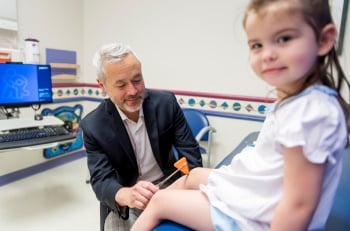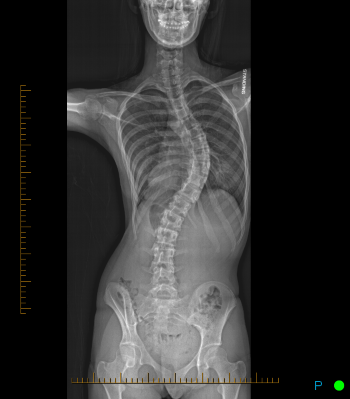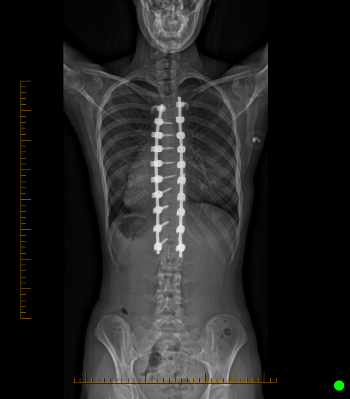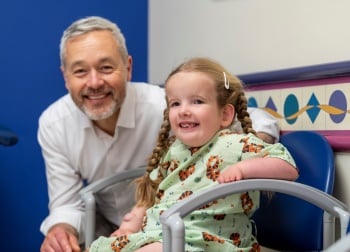Spinal Fusion
Posterior spinal fusion

Posterior spinal fusion with instrumentation is the most common procedure performed for pediatric spinal conditions such as scoliosis and pathologic forms of kyphosis. Surgery is typically indicated if the spinal curve measures greater than 50 degrees. Anterior fusion may also be an option in certain cases. Your surgeon will discuss this with you if your child is a candidate. The goal of posterior spinal fusion with instrumentation in the setting of spinal deformity is to prevent progression and improve spinal balance.
Posterior spinal fusion with instrumentation usually entails placing anchors on the spine such as screws, hooks, or wires that attach to a rod placed on each side of the spine. These implants are used to correct the spinal deformity and maintain the correction while the fusion process occurs. Bone graft, which consists of chips of bone, is then placed along the spine to encourage the fusion process. The implants are typically not removed.
Your surgeon will discuss what limitations of activity they would like for your child to follow once surgery has been completed. Bracing is not usually necessary after surgery.


What to expect with surgery
A posterior spinal fusion is a long complex surgery and not without risks.
- Time: The surgery typically takes approximately four hours for an otherwise healthy young person with idiopathic scoliosis. It can take a little longer for a patient with Scheuermann’s Kyphosis. In more medically complex children, such as with neuromuscular scoliosis, this surgery may take closer to 5-6 hours.
- Blood transfusions: Some children will require blood transfusions during and sometimes after the surgery. Your surgeon will discuss your child’s risk of needing a blood transfusion at their preoperative discussion.
- Spinal cord monitoring: Most children have neuromonitoring throughout the operation by a staff member specially trained in this technique.
- Infection prevention: your child will receive many interventions to cut down on the risk of infection.
- During your preoperative discussion, you will be provided with a prescription for a strong antibiotic ointment (Mupirocin) that you will place in your child’s nostrils and along their future incision site (usually down the middle of their back) for 5 days before surgery.
- Additionally, your surgical team will instruct you on the use of chlorhexidine wipes prior to surgery as well. These will be provided for you by your spine team.
- During the surgery, your child will receive high-dose antibiotics regularly throughout the case and after it is completed to combat any infection risk as well.
- The spine teams are continuously working to find new ways to keep our patients free from infection.
- Pain management: Pain after surgery is controlled via a multi-modal pain management approach. Some patients will be on patient-controlled analgesia (pain pump) immediately following surgery but will transition to taking pain medications by mouth as soon as possible. Our spine care team is now using Exparel (an extended-release numbing medicine), which is injected into the muscles and tissues around the spine to provide non-opioid pain relief for several days after surgery. Your child will also be placed on an ERAS (Enhanced Recovery After Surgery) protocol for a multidisciplinary approach to their care in order to improve outcomes and recovery from their procedure.
- Hospital stay: Total hospitalization time is usually 2 to 3 days. Intensive care stay is not indicated for this surgery in an otherwise healthy young person. However, more medically complex children may require immediate postoperative stay in the Pediatric Intensive Care Unit and a longer hospitalization.
What to expect after surgery

Your child will be discharged once they are comfortable on oral pain medications, eating well, and mobilizing well with physical therapy. Once your child is discharged home, they should be able to walk stairs and sleep in their own bed. We also want them to have adequate pain control, so they will be sent home with pain medications.
Normally, patients are out of school for 3 to 6 weeks. Your spine team will provide a note with clear instructions to facilitate a smooth transition back into their school life. They should not, however, return to gym or sports until cleared by their spine surgeon.
Halo Gravity Traction
This technique applies traction to the spine using a halo (metal ring that surrounds the head). The goal of halo gravity traction is to stretch out the spine slowly and carefully prior to a scheduled spine surgery.
- Spine Care
- Bracing Options for Scoliosis
- Growing Rods
- Halo Gravity Traction
- iSpine Clinic
- Mehta Casting
- Microdiscectomy for Disc Herniation
- Outreach Services
- Spinal Fusion
- Spine Care Consultations
- Spine Surgery: What to Expect
- Spondylolysis and Spondylolisthesis
- Vertebral Body Tethering
- Meet the Team
- Orthopedics
